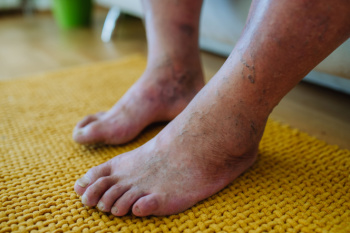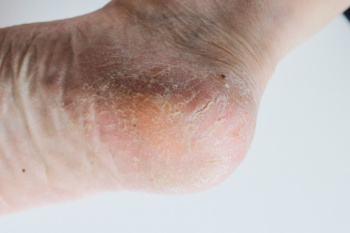
Pain in the big toe can stem from medical conditions that affect the joints, bones, tendons, or soft tissue. One common cause of big toe pain is arthritis, which can lead to stiffness and swelling in the joint that connects the big toe to the foot. This joint, called the first metatarsophalangeal, or MTP joint, plays a major role in walking and bearing weight. Gout, bunions, and sesamoiditis can also trigger inflammation and discomfort in the big toe. Trauma from sports injuries, including turf toe or a toe fracture, can result in lingering toe pain. Bursitis, the inflammation of fluid-filled sacs that cushion the MTP joint, may also contribute to tenderness and restricted motion. A podiatrist can diagnose the cause of your big toe pain and determine the proper treatment plan. If you are experiencing this type of pain, it is suggested that you schedule an appointment with a podiatrist.
Toe pain can disrupt your daily activities. If you have any concerns, contact Brian Shwer, DPM of Southaven Foot Clinic. Our doctor can provide the care you need to keep you pain-free and on your feet.
What Causes Toe Pain?
Most severe toe pain is caused due to a sports injury, trauma from dropping something heavy on the toe, or bumping into something rigid. Other problems can develop over time for various reasons.
Toe pain can be caused by one or more ailments. The most common include:
When to See a Podiatrist
Diagnosis
In many cases the cause of toe pain is obvious, but in others, a podiatrist may want to use more advanced methods to determine the problem. These can range from simple visual inspections and sensation tests to X-rays and MRI scans. Prior medical history, family medical history, and any recent physical traumatic events will all be taken into consideration for a proper diagnosis.
Treatment
Treatments for toe pain and injuries vary and may include shoe inserts, padding, taping, medicines, injections, and in some cases, surgery. If you believe that you have broken a toe, please see a podiatrist as soon as possible.
If you have any questions please feel free to contact our office located in Southaven, MS . We offer the newest diagnostic tools and technology to treat your foot and ankle needs.

An ankle sprain injury occurs when the ligaments supporting the ankle stretch or tear, typically due to sudden twisting or rolling of the foot. This injury is frequent in sports and physical activities but can also result from uneven surfaces or wearing unsupportive footwear. The most commonly affected ligaments are on the outside of the ankle, which are more vulnerable when the foot rolls inward. Symptoms often include pain, swelling, bruising, and difficulty bearing weight. To diagnose an ankle sprain, a podiatrist will perform a physical examination and assess the range of motion, stability, and tenderness. Imaging studies, such as an X-ray or MRI scan, may be used to rule out fractures or more serious ligament damage. If you have injured your ankle, it is suggested that you promptly contact a podiatrist who can provide an accurate diagnosis and treatment.
Although ankle sprains are common, they aren’t always minor injuries. If you need your ankle injury looked at, contact Brian Shwer, DPM from Southaven Foot Clinic. Our doctor can provide the care you need to keep you pain-free and on your feet.
How Does an Ankle Sprain Occur?
Ankle sprains are the result of a tear in the ligaments within the ankle. These injuries may happen when you make a rapid shifting movement while your foot is planted. A less common way to sprain your ankle is when your ankle rolls inward while your foot turns outward.
What Are the Symptoms?
Preventing a Sprain
Treatment of a Sprain
In many cases, the RICE method (Rest, Ice, Compression, and Elevate) is used to treat ankle sprains. However, you should see a podiatrist to see which treatment option would work best with your injury. In severe cases, surgery may be required.
It is important to ask your doctor about rehab options after you receive treatment for your injury. Stretching, strength training, and balance exercises may help the ankle heal while also preventing further injury.
If you have any questions, please feel free to contact our office located in Southaven, MS . We offer the newest diagnostic and treatment technologies for all your foot care needs.

Diabetes can affect your feet in ways that are not always obvious at first. Reduced blood flow and nerve damage may lead to numbness, tingling, or a loss of sensation, making it easy to overlook injuries or irritation. You may not notice a blister, cut, or sore until it becomes infected or fails to heal. Swelling, redness, or drainage from a wound are signs that should not be ignored. Changes in skin color or temperature, especially when paired with pain or unusual smells, may indicate more serious issues like infection or poor circulation. Even dry, cracked skin can be a warning sign. Because diabetic foot problems can develop quickly and lead to serious complications, early attention is essential. Regular foot checks are important, but if you observe any of these signs or changes, it is suggested that you see a podiatrist who can help you to manage this condition.
Diabetic foot care is important in preventing foot ailments such as ulcers. If you are suffering from diabetes or have any other concerns about your feet, contact Brian Shwer, DPM from Southaven Foot Clinic. Our doctor can provide the care you need to keep you pain-free and on your feet.
Diabetic Foot Care
Diabetes affects millions of people every year. The condition can damage blood vessels in many parts of the body, especially the feet. Because of this, taking care of your feet is essential if you have diabetes, and having a podiatrist help monitor your foot health is highly recommended.
The Importance of Caring for Your Feet
Patients with diabetes should have their doctor monitor their blood levels, as blood sugar levels play such a huge role in diabetic care. Monitoring these levels on a regular basis is highly advised.
It is always best to inform your healthcare professional of any concerns you may have regarding your feet, especially for diabetic patients. Early treatment and routine foot examinations are keys to maintaining proper health, especially because severe complications can arise if proper treatment is not applied.
If you have any questions please feel free to contact our office located in Southaven, MS . We offer the newest diagnostic and treatment technologies for all your foot and ankle needs.

The condition of the feet can provide important clues about overall health. Poor circulation, often linked to diabetes or vascular disease, may cause cold feet, numbness, or slow-healing wounds. Changes in toenails, such as discoloration or thickening, can indicate fungal infections or underlying medical conditions. The arches of the feet play a role in posture and alignment, and issues such as flat feet or high arches may contribute to joint pain and imbalance. Skin conditions, including dryness, cracks, or unusual rashes, may signal nutritional deficiencies or autoimmune disorders. Persistent foot odor, beyond normal sweating, can suggest bacterial or fungal infections. If you notice any changes to your feet, it is suggested that you visit a podiatrist who can link any of these changes to possible health issues and provide treatment.
When dealing with systemic disease of the feet, it is extremely important to check the affected areas routinely so that any additional problems are caught quickly. If you have any concerns about your feet and ankles contact Brian Shwer, DPM from Southaven Foot Clinic. Our doctor will assist you with all of your podiatric needs.
Systemic Diseases of the Feet
Systemic diseases affect the whole body, and symptoms usually are displayed in the feet. This condition can make a patient’s ability to walk unbearable. Systemic diseases include gout, diabetes mellitus, neurological disorders, and arthritis.
Gout – is caused by an excess of uric acid in the body. Common symptoms include pain, inflammation, and redness at the metatarsal/phalangeal joint of the base big toe. Gout can be treated by NSAIDs to relieve pain and inflammation, and other drugs that lower the acid levels in the body.
Diabetes mellitus – is an increase in the level of blood sugar that the body cannot counteract with its own insulin. Failure to produce enough insulin is a factor in Diabetes.
Diabetes of the Feet
Diabetic Neuropathy – may lead to damaged nerves and affect the feet through numbness and loss of sensation.
Peripheral Vascular Disease – can restrict the blood flow to the feet, and often times lead to amputation of the feet.
If you have any questions please feel free to contact our office located in Southaven, MS . We offer the newest diagnostic and treatment technologies for all your foot and ankle needs.

Choosing the right footwear for weightlifting is essential for maintaining foot and ankle stability during heavy lifts. Weightlifting shoes differ from regular sneakers by offering a firm, non-compressible sole and an elevated heel. This enhances ankle mobility and allows for a deeper squat position, while keeping the foot stable. A proper lifting shoe minimizes excessive movement, which reduces the risk of rolling an ankle or placing undue pressure on the toes. Standard athletic shoes with soft soles can create instability, increasing the likelihood of foot fatigue and misalignment. Shoes with a secure strap system can further support the midfoot, preventing unnecessary shifting during lifts. People with existing foot concerns, such as flat feet or limited ankle mobility, may benefit from custom orthotics within their weightlifting shoes to ensure proper alignment. A podiatrist can assess your foot structure and gait mechanics to help determine which footwear best promotes stability and reduces strain on your feet. If you experience foot pain after a weight-lifting workout, it is suggested that you schedule an appointment with a podiatrist for an exam and diagnosis.
Getting the right shoe size is an important part of proper foot health. Seek the assistance of Brian Shwer, DPM from Southaven Foot Clinic. Our doctor will provide the care you need to keep you pain-free and on your feet.
Getting the Right Shoe Size
There are many people who wear shoes that are the incorrect size, negatively affecting their feet and posture. Selecting the right shoes is not a difficult process, so long as you keep several things in mind when it comes to choosing the right pair.
As our feet hold our body weight and keep us moving, it is important to treat them right. Picking the right pair of shoes can provide your feet comfort and mobility without pain.
If you have any questions, please feel free to contact our office located in Southaven, MS . We offer the newest diagnostic and treatment technologies for all your foot care needs.

Cracked heels develop when the skin on the feet becomes dry and loses its elasticity, leading to painful fissures. One common cause is prolonged pressure on the feet from standing for long hours or wearing shoes with inadequate support. Dry skin, often worsened by cold weather or dehydration, makes the heels more prone to cracking. Athlete's foot, a fungal infection, can cause peeling and flaking that leads to skin breakdown. Conditions such as eczema and psoriasis contribute to excessive dryness and inflammation, further increasing the risk of heel fissures. Without proper care, cracks can deepen and cause discomfort or infection. If you notice the beginning symptoms of cracked heels, it is suggested that you promptly contact a podiatrist who can offer you effective relief and prevention tips.
If the skin on your feet starts to crack, you may want to see a podiatrist to find treatment. If you have any concerns, contact Brian Shwer, DPM from Southaven Foot Clinic. Our doctor can provide the care you need to keep you pain-free and on your feet.
Cracked Heels
It is important to moisturize your cracked heels in order to prevent pain, bleeding, and infection. The reason cracked heels form is because the skin on the foot is too dry to support the immense pressure placed on them. When the foot expands, the dry skin on the foot begins to split.
Ways to Help Heal Them
Ways to Prevent Cracked Heels
If you are unsure how to proceed in treating cracked heels, seek guidance from a podiatrist. Your doctor will help you with any questions or information you may need.
If you have any questions, please feel free to contact our office located in Southaven, MS . We offer the newest diagnostic and treatment technologies for all your foot care needs.

Arthritis in the toes can feel like a deep, aching pain that worsens with movement. Stiffness, swelling, and tenderness are common, making it difficult to walk or wear certain shoes. Some people notice a grinding sensation as the cartilage wears down, while others experience redness and warmth surrounding the joints. Over time, deformities like bunions or clawed toes may develop. This condition happens when the protective cartilage in the toe joints deteriorates, leading to bone-on-bone friction. Osteoarthritis is the most common type, often linked to aging, past injuries, or genetics. Rheumatoid arthritis, an autoimmune disease, can also cause painful inflammation in the toes. Anyone can develop arthritis, but it is more common in older adults, athletes, and those with a family history. If toe pain is limiting your mobility, it is suggested that you see a podiatrist who can provide an accurate diagnosis and treatment.
Toe pain can disrupt your daily activities. If you have any concerns, contact Brian Shwer, DPM of Southaven Foot Clinic. Our doctor can provide the care you need to keep you pain-free and on your feet.
What Causes Toe Pain?
Most severe toe pain is caused due to a sports injury, trauma from dropping something heavy on the toe, or bumping into something rigid. Other problems can develop over time for various reasons.
Toe pain can be caused by one or more ailments. The most common include:
When to See a Podiatrist
Diagnosis
In many cases the cause of toe pain is obvious, but in others, a podiatrist may want to use more advanced methods to determine the problem. These can range from simple visual inspections and sensation tests to X-rays and MRI scans. Prior medical history, family medical history, and any recent physical traumatic events will all be taken into consideration for a proper diagnosis.
Treatment
Treatments for toe pain and injuries vary and may include shoe inserts, padding, taping, medicines, injections, and in some cases, surgery. If you believe that you have broken a toe, please see a podiatrist as soon as possible.
If you have any questions please feel free to contact our office located in Southaven, MS . We offer the newest diagnostic tools and technology to treat your foot and ankle needs.

Morton's neuroma involves damage and inflammation of the nerves between the toes, most often between the third and fourth toes. Patients typically experience sharp, burning pain, tingling, or numbness extending from the ball of the foot into the toes. Many describe the sensation as walking with a small stone or pebble under the foot. Morton’s neuroma often arises from continuous pressure or irritation of the nerve. It may be caused by wearing tight shoes, high heels, or foot abnormalities such as bunions, hammertoe, or flat arches. Participation in high-impact activities like running also may contribute to such nerve injury. Treatment from a podiatrist includes customized orthotic shoe inserts, steroid injections to relieve inflammation, and possibly surgery to remove the affected nerve, or releasing pressure by cutting surrounding ligaments. If you have ongoing sharp, burning pain under your toes, it is suggested that you scheduled an appointment with a podiatrist for an exam, diagnosis, and treatment.
Morton’s neuroma is a very uncomfortable condition to live with. If you think you have Morton’s neuroma, contact Brian Shwer, DPM of Southaven Foot Clinic. Our doctor will attend to all of your foot care needs and answer any of your related questions.
Morton’s Neuroma
Morton's neuroma is a painful foot condition that commonly affects the areas between the second and third or third and fourth toe, although other areas of the foot are also susceptible. Morton’s neuroma is caused by an inflamed nerve in the foot that is being squeezed and aggravated by surrounding bones.
What Increases the Chances of Having Morton’s Neuroma?
Morton’s neuroma is a very treatable condition. Orthotics and shoe inserts can often be used to alleviate the pain on the forefront of the feet. In more severe cases, corticosteroids can also be prescribed. In order to figure out the best treatment for your neuroma, it’s recommended to seek the care of a podiatrist who can diagnose your condition and provide different treatment options.
If you have any questions, please feel free to contact our office located in Southaven, MS . We offer the newest diagnostic and treatment technologies for all your foot care needs.